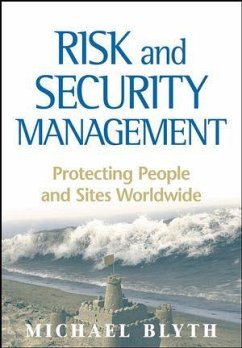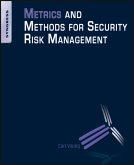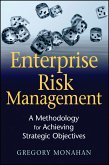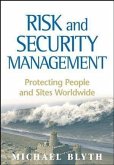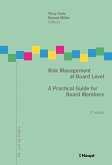80,99 €
80,99 €
inkl. MwSt.
Sofort per Download lieferbar

0 °P sammeln
80,99 €
Als Download kaufen

80,99 €
inkl. MwSt.
Sofort per Download lieferbar

0 °P sammeln
Jetzt verschenken
Alle Infos zum eBook verschenken
80,99 €
inkl. MwSt.
Sofort per Download lieferbar
Alle Infos zum eBook verschenken

0 °P sammeln
- Format: ePub
- Merkliste
- Auf die Merkliste
- Bewerten Bewerten
- Teilen
- Produkt teilen
- Produkterinnerung
- Produkterinnerung

Bitte loggen Sie sich zunächst in Ihr Kundenkonto ein oder registrieren Sie sich bei
bücher.de, um das eBook-Abo tolino select nutzen zu können.
Hier können Sie sich einloggen
Hier können Sie sich einloggen
Sie sind bereits eingeloggt. Klicken Sie auf 2. tolino select Abo, um fortzufahren.

Bitte loggen Sie sich zunächst in Ihr Kundenkonto ein oder registrieren Sie sich bei bücher.de, um das eBook-Abo tolino select nutzen zu können.
Learn to measure risk and develop a plan to protect employees and company interests by applying the advice and tools in Risk and Security Management: Protecting People and Sites Worldwide. In a world concerned with global terrorism, instability of emerging markets, and hazardous commercial operations, this book shines as a relevant and timely text with a plan you can easily apply to your organization. Find a series of strategic to granular level policies, systems, and concepts which identify and address risk, enabling business to occur in a manner which best protects you and your company.
- Geräte: eReader
- mit Kopierschutz
- eBook Hilfe
- Größe: 9.96MB
Andere Kunden interessierten sich auch für
![Metrics and Methods for Security Risk Management (eBook, ePUB) Metrics and Methods for Security Risk Management (eBook, ePUB)]() Carl YoungMetrics and Methods for Security Risk Management (eBook, ePUB)23,95 €
Carl YoungMetrics and Methods for Security Risk Management (eBook, ePUB)23,95 €![Risk Management for IT Projects (eBook, ePUB) Risk Management for IT Projects (eBook, ePUB)]() Bennet LientzRisk Management for IT Projects (eBook, ePUB)62,95 €
Bennet LientzRisk Management for IT Projects (eBook, ePUB)62,95 €![Enterprise Risk Management (eBook, ePUB) Enterprise Risk Management (eBook, ePUB)]() Gregory MonahanEnterprise Risk Management (eBook, ePUB)51,99 €
Gregory MonahanEnterprise Risk Management (eBook, ePUB)51,99 €![Managing Risk: The HR Contribution (eBook, ePUB) Managing Risk: The HR Contribution (eBook, ePUB)]() John StevensManaging Risk: The HR Contribution (eBook, ePUB)78,95 €
John StevensManaging Risk: The HR Contribution (eBook, ePUB)78,95 €![Risk and Security Management (eBook, PDF) Risk and Security Management (eBook, PDF)]() Michael BlythRisk and Security Management (eBook, PDF)80,99 €
Michael BlythRisk and Security Management (eBook, PDF)80,99 €![Measures and Metrics in Corporate Security (eBook, ePUB) Measures and Metrics in Corporate Security (eBook, ePUB)]() George CampbellMeasures and Metrics in Corporate Security (eBook, ePUB)55,95 €
George CampbellMeasures and Metrics in Corporate Security (eBook, ePUB)55,95 €![Risk Management at Board Level (eBook, ePUB) Risk Management at Board Level (eBook, ePUB)]() Vinay KaliaRisk Management at Board Level (eBook, ePUB)23,99 €
Vinay KaliaRisk Management at Board Level (eBook, ePUB)23,99 €-
-
-
Learn to measure risk and develop a plan to protect employees and company interests by applying the advice and tools in Risk and Security Management: Protecting People and Sites Worldwide. In a world concerned with global terrorism, instability of emerging markets, and hazardous commercial operations, this book shines as a relevant and timely text with a plan you can easily apply to your organization. Find a series of strategic to granular level policies, systems, and concepts which identify and address risk, enabling business to occur in a manner which best protects you and your company.
Dieser Download kann aus rechtlichen Gründen nur mit Rechnungsadresse in D ausgeliefert werden.
Produktdetails
- Produktdetails
- Verlag: John Wiley & Sons
- Erscheinungstermin: 14. Mai 2015
- Englisch
- ISBN-13: 9781119139713
- Artikelnr.: 42885797
- Verlag: John Wiley & Sons
- Erscheinungstermin: 14. Mai 2015
- Englisch
- ISBN-13: 9781119139713
- Artikelnr.: 42885797
- Herstellerkennzeichnung Die Herstellerinformationen sind derzeit nicht verfügbar.
Michael Blyth is a former Royal Marine Commando officer and has held/holds commercial vice president appointments both in operations as well as business strategies within two major international risk consulting and security companies. He has eighteen years of experience and a master's degree in security and risk management. He is highly experienced in providing corporate risk mitigation and vulnerability assessments, crisis management plans, and a wide spectrum of security documents within high-risk environments for ambassadors, major oil and gas programs, communications network corporations, government organizations, development agencies, and a myriad of construction activities, effectively placing risk management into the context of a client's commercial activity and budget constraints. He speaks on security and risk throughout the world, has been published in several security industry magazines, and has lived or worked in over thirty countries.
Preface.
Acknowledgements.
Chapter 1. Risk Consultancy and Security Management.
Project Planning.
Balancing Service Delivery.
Company and Vendor Relationships.
Consultant's Objectives.
Consultant Skill Areas.
Principle Consultant Errors.
Chapter 2. Initiating New Contracts.
Business Cycle.
Proposals.
Proposal Concepts.
Proposal Process.
Analyzing the Request for Proposal
Proposal.
Evaluating the Proposal.
Proposal Production.
Chapter 3. Service Delivery and Quality Assurance.
Common Vendor and Company Failings.
Understanding the Activity.
Service Delivery Support.
Managing Service Delivery.
Quality Assurance Plans.
Reports and Returns.
Management Systems.
Management Considerations.
Coordination with External Agencies.
Media Management.
Personnel and Training.
Contract Management
Chapter 4. Threat Evaluation and Risk Management.
Risk Areas.
Risk Management Plans.
Implementing the Risk Management Plan.
Risk Assessment.
Impact Assessments.
Risk Levels.
Presenting Risk.
Contingency Planning.
Crisis Management.
Crisis Management Team Levels and Structures.
Crisis Management Team Structure.
Incident Response Teams.
Crisis Management Tools.
Types of Crisis Management Responses.
Post-Incident Review.
Monitoring the Risk Management Program.
Chapter 5. Scope of Risk.
Nonphysical Threats.
Physical Risks.
Domestic Terrorism.
Chapter 6. Consultancy Services.
Due Diligence.
Investigations.
Forensics.
Information Security.
Screening.
Security Management Design.
Security Structural Design.
Crisis Management.
Governance and Development.
Political Analysis.
Security Consulting Services.
Auditing Consultancy.
Chapter7. Project Management.
Project Failure.
Project Life Cycle.
Project Planning.
Project Design.
Project Start Up.
Project Initiation.
Project Management Structures.
Risk and Security Project Management.
Management Catagories.
Project Controls.
Project Integration.
Chapter 8. Mobile Security Services.
Understanding the Need.
PSD Structuring.
Management Principles.
Process Interfaces.
Innovations.
PSD Tactical Principles.
Mobile Security Conduct.
PSD Personnel Selection.
Medical Provision.
Vehicle Considerations.
Convoys.
Chapter 9. Facility Security Services.
Fixed Camps and Forward Operating Bases.
Mobile Facility Security.
Facility Security Management.
Relief in Place.
Security Considerations.
Layering Security.
Physical Security Structures.
Security Surveillance and Lighting.
Conventional Security Policies.
Evacuation Planning.
Chapter 10. Evacuation Planning.
Evacuation Principles.
Evacuation Plan Elements.
Evacuation Management.
Process Planning.
Evacuation Triggers.
Alert States.
Evacuation Plan Components.
Recovery Management.
Chapter 11. Disaster Response Management.
Humanitarian Operating Environment.
Working with Governments.
Management Preparation.
Principles of Disaster Response.
Stages of Disasters.
Disaster Management.
Preparedess Plans.
Mobilization.
Sustainment and Demobilization.
Chapter 12. Security Documents and Exhibits.
Consultancy Process.
Intelligence Reviews.
Threat Assessments.
Security Surveys.
Operations Order or Mobilization Plans.
Security Plan.
Security Audit.
Incident Management Plans.
Chapter 13. Government versus Commercial Contracting.
Differences between U.S. Government and Commercial Contracts.
Government Contracting.
Market Size and Scope.
U.S. Government Structure for Acquisition.
Acquisitions.
Federal Acquisition Regulation System.
Contracting Authorities.
Procurement Method.
RFP and the Uniform Contract Format.
Evaluation.
Contract Award and Administration.
Types of Contract.
Index.
Acknowledgements.
Chapter 1. Risk Consultancy and Security Management.
Project Planning.
Balancing Service Delivery.
Company and Vendor Relationships.
Consultant's Objectives.
Consultant Skill Areas.
Principle Consultant Errors.
Chapter 2. Initiating New Contracts.
Business Cycle.
Proposals.
Proposal Concepts.
Proposal Process.
Analyzing the Request for Proposal
Proposal.
Evaluating the Proposal.
Proposal Production.
Chapter 3. Service Delivery and Quality Assurance.
Common Vendor and Company Failings.
Understanding the Activity.
Service Delivery Support.
Managing Service Delivery.
Quality Assurance Plans.
Reports and Returns.
Management Systems.
Management Considerations.
Coordination with External Agencies.
Media Management.
Personnel and Training.
Contract Management
Chapter 4. Threat Evaluation and Risk Management.
Risk Areas.
Risk Management Plans.
Implementing the Risk Management Plan.
Risk Assessment.
Impact Assessments.
Risk Levels.
Presenting Risk.
Contingency Planning.
Crisis Management.
Crisis Management Team Levels and Structures.
Crisis Management Team Structure.
Incident Response Teams.
Crisis Management Tools.
Types of Crisis Management Responses.
Post-Incident Review.
Monitoring the Risk Management Program.
Chapter 5. Scope of Risk.
Nonphysical Threats.
Physical Risks.
Domestic Terrorism.
Chapter 6. Consultancy Services.
Due Diligence.
Investigations.
Forensics.
Information Security.
Screening.
Security Management Design.
Security Structural Design.
Crisis Management.
Governance and Development.
Political Analysis.
Security Consulting Services.
Auditing Consultancy.
Chapter7. Project Management.
Project Failure.
Project Life Cycle.
Project Planning.
Project Design.
Project Start Up.
Project Initiation.
Project Management Structures.
Risk and Security Project Management.
Management Catagories.
Project Controls.
Project Integration.
Chapter 8. Mobile Security Services.
Understanding the Need.
PSD Structuring.
Management Principles.
Process Interfaces.
Innovations.
PSD Tactical Principles.
Mobile Security Conduct.
PSD Personnel Selection.
Medical Provision.
Vehicle Considerations.
Convoys.
Chapter 9. Facility Security Services.
Fixed Camps and Forward Operating Bases.
Mobile Facility Security.
Facility Security Management.
Relief in Place.
Security Considerations.
Layering Security.
Physical Security Structures.
Security Surveillance and Lighting.
Conventional Security Policies.
Evacuation Planning.
Chapter 10. Evacuation Planning.
Evacuation Principles.
Evacuation Plan Elements.
Evacuation Management.
Process Planning.
Evacuation Triggers.
Alert States.
Evacuation Plan Components.
Recovery Management.
Chapter 11. Disaster Response Management.
Humanitarian Operating Environment.
Working with Governments.
Management Preparation.
Principles of Disaster Response.
Stages of Disasters.
Disaster Management.
Preparedess Plans.
Mobilization.
Sustainment and Demobilization.
Chapter 12. Security Documents and Exhibits.
Consultancy Process.
Intelligence Reviews.
Threat Assessments.
Security Surveys.
Operations Order or Mobilization Plans.
Security Plan.
Security Audit.
Incident Management Plans.
Chapter 13. Government versus Commercial Contracting.
Differences between U.S. Government and Commercial Contracts.
Government Contracting.
Market Size and Scope.
U.S. Government Structure for Acquisition.
Acquisitions.
Federal Acquisition Regulation System.
Contracting Authorities.
Procurement Method.
RFP and the Uniform Contract Format.
Evaluation.
Contract Award and Administration.
Types of Contract.
Index.
Preface.
Acknowledgements.
Chapter 1. Risk Consultancy and Security Management.
Project Planning.
Balancing Service Delivery.
Company and Vendor Relationships.
Consultant's Objectives.
Consultant Skill Areas.
Principle Consultant Errors.
Chapter 2. Initiating New Contracts.
Business Cycle.
Proposals.
Proposal Concepts.
Proposal Process.
Analyzing the Request for Proposal
Proposal.
Evaluating the Proposal.
Proposal Production.
Chapter 3. Service Delivery and Quality Assurance.
Common Vendor and Company Failings.
Understanding the Activity.
Service Delivery Support.
Managing Service Delivery.
Quality Assurance Plans.
Reports and Returns.
Management Systems.
Management Considerations.
Coordination with External Agencies.
Media Management.
Personnel and Training.
Contract Management
Chapter 4. Threat Evaluation and Risk Management.
Risk Areas.
Risk Management Plans.
Implementing the Risk Management Plan.
Risk Assessment.
Impact Assessments.
Risk Levels.
Presenting Risk.
Contingency Planning.
Crisis Management.
Crisis Management Team Levels and Structures.
Crisis Management Team Structure.
Incident Response Teams.
Crisis Management Tools.
Types of Crisis Management Responses.
Post-Incident Review.
Monitoring the Risk Management Program.
Chapter 5. Scope of Risk.
Nonphysical Threats.
Physical Risks.
Domestic Terrorism.
Chapter 6. Consultancy Services.
Due Diligence.
Investigations.
Forensics.
Information Security.
Screening.
Security Management Design.
Security Structural Design.
Crisis Management.
Governance and Development.
Political Analysis.
Security Consulting Services.
Auditing Consultancy.
Chapter7. Project Management.
Project Failure.
Project Life Cycle.
Project Planning.
Project Design.
Project Start Up.
Project Initiation.
Project Management Structures.
Risk and Security Project Management.
Management Catagories.
Project Controls.
Project Integration.
Chapter 8. Mobile Security Services.
Understanding the Need.
PSD Structuring.
Management Principles.
Process Interfaces.
Innovations.
PSD Tactical Principles.
Mobile Security Conduct.
PSD Personnel Selection.
Medical Provision.
Vehicle Considerations.
Convoys.
Chapter 9. Facility Security Services.
Fixed Camps and Forward Operating Bases.
Mobile Facility Security.
Facility Security Management.
Relief in Place.
Security Considerations.
Layering Security.
Physical Security Structures.
Security Surveillance and Lighting.
Conventional Security Policies.
Evacuation Planning.
Chapter 10. Evacuation Planning.
Evacuation Principles.
Evacuation Plan Elements.
Evacuation Management.
Process Planning.
Evacuation Triggers.
Alert States.
Evacuation Plan Components.
Recovery Management.
Chapter 11. Disaster Response Management.
Humanitarian Operating Environment.
Working with Governments.
Management Preparation.
Principles of Disaster Response.
Stages of Disasters.
Disaster Management.
Preparedess Plans.
Mobilization.
Sustainment and Demobilization.
Chapter 12. Security Documents and Exhibits.
Consultancy Process.
Intelligence Reviews.
Threat Assessments.
Security Surveys.
Operations Order or Mobilization Plans.
Security Plan.
Security Audit.
Incident Management Plans.
Chapter 13. Government versus Commercial Contracting.
Differences between U.S. Government and Commercial Contracts.
Government Contracting.
Market Size and Scope.
U.S. Government Structure for Acquisition.
Acquisitions.
Federal Acquisition Regulation System.
Contracting Authorities.
Procurement Method.
RFP and the Uniform Contract Format.
Evaluation.
Contract Award and Administration.
Types of Contract.
Index.
Acknowledgements.
Chapter 1. Risk Consultancy and Security Management.
Project Planning.
Balancing Service Delivery.
Company and Vendor Relationships.
Consultant's Objectives.
Consultant Skill Areas.
Principle Consultant Errors.
Chapter 2. Initiating New Contracts.
Business Cycle.
Proposals.
Proposal Concepts.
Proposal Process.
Analyzing the Request for Proposal
Proposal.
Evaluating the Proposal.
Proposal Production.
Chapter 3. Service Delivery and Quality Assurance.
Common Vendor and Company Failings.
Understanding the Activity.
Service Delivery Support.
Managing Service Delivery.
Quality Assurance Plans.
Reports and Returns.
Management Systems.
Management Considerations.
Coordination with External Agencies.
Media Management.
Personnel and Training.
Contract Management
Chapter 4. Threat Evaluation and Risk Management.
Risk Areas.
Risk Management Plans.
Implementing the Risk Management Plan.
Risk Assessment.
Impact Assessments.
Risk Levels.
Presenting Risk.
Contingency Planning.
Crisis Management.
Crisis Management Team Levels and Structures.
Crisis Management Team Structure.
Incident Response Teams.
Crisis Management Tools.
Types of Crisis Management Responses.
Post-Incident Review.
Monitoring the Risk Management Program.
Chapter 5. Scope of Risk.
Nonphysical Threats.
Physical Risks.
Domestic Terrorism.
Chapter 6. Consultancy Services.
Due Diligence.
Investigations.
Forensics.
Information Security.
Screening.
Security Management Design.
Security Structural Design.
Crisis Management.
Governance and Development.
Political Analysis.
Security Consulting Services.
Auditing Consultancy.
Chapter7. Project Management.
Project Failure.
Project Life Cycle.
Project Planning.
Project Design.
Project Start Up.
Project Initiation.
Project Management Structures.
Risk and Security Project Management.
Management Catagories.
Project Controls.
Project Integration.
Chapter 8. Mobile Security Services.
Understanding the Need.
PSD Structuring.
Management Principles.
Process Interfaces.
Innovations.
PSD Tactical Principles.
Mobile Security Conduct.
PSD Personnel Selection.
Medical Provision.
Vehicle Considerations.
Convoys.
Chapter 9. Facility Security Services.
Fixed Camps and Forward Operating Bases.
Mobile Facility Security.
Facility Security Management.
Relief in Place.
Security Considerations.
Layering Security.
Physical Security Structures.
Security Surveillance and Lighting.
Conventional Security Policies.
Evacuation Planning.
Chapter 10. Evacuation Planning.
Evacuation Principles.
Evacuation Plan Elements.
Evacuation Management.
Process Planning.
Evacuation Triggers.
Alert States.
Evacuation Plan Components.
Recovery Management.
Chapter 11. Disaster Response Management.
Humanitarian Operating Environment.
Working with Governments.
Management Preparation.
Principles of Disaster Response.
Stages of Disasters.
Disaster Management.
Preparedess Plans.
Mobilization.
Sustainment and Demobilization.
Chapter 12. Security Documents and Exhibits.
Consultancy Process.
Intelligence Reviews.
Threat Assessments.
Security Surveys.
Operations Order or Mobilization Plans.
Security Plan.
Security Audit.
Incident Management Plans.
Chapter 13. Government versus Commercial Contracting.
Differences between U.S. Government and Commercial Contracts.
Government Contracting.
Market Size and Scope.
U.S. Government Structure for Acquisition.
Acquisitions.
Federal Acquisition Regulation System.
Contracting Authorities.
Procurement Method.
RFP and the Uniform Contract Format.
Evaluation.
Contract Award and Administration.
Types of Contract.
Index.
"It is, in fact, a relevant and timely book that provides practical instruction regarding the need to assess risk and implement protection of a company s assets to safeguard its people and facilities. What sets this book above others on its topic is its emphasis on programs that avoid the waste of time, effort, and resources." ( Bookviews.com , October 2008)
